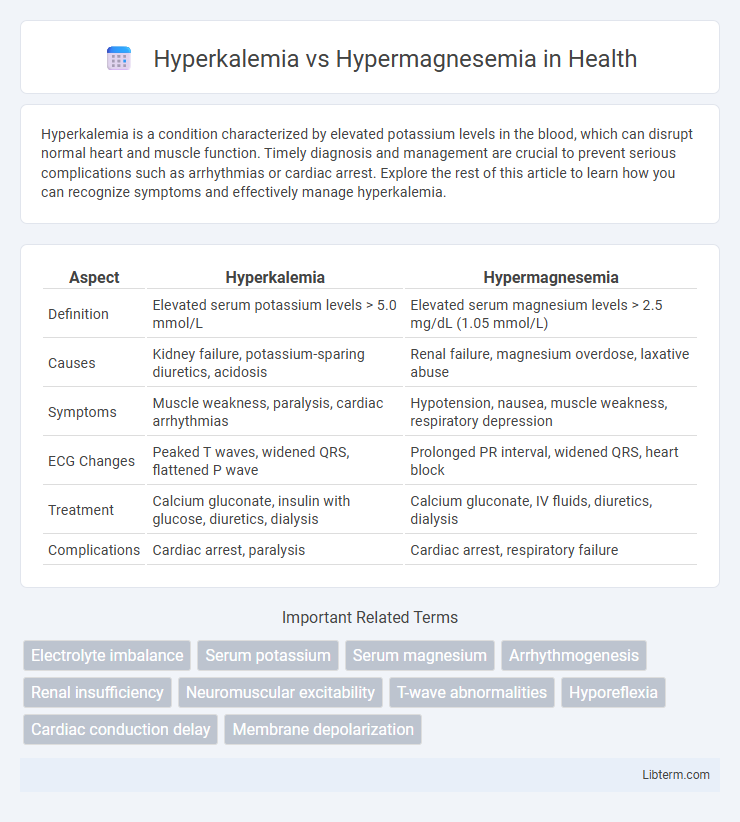Hyperkalemia is a condition characterized by elevated potassium levels in the blood, which can disrupt normal heart and muscle function. Timely diagnosis and management are crucial to prevent serious complications such as arrhythmias or cardiac arrest. Explore the rest of this article to learn how you can recognize symptoms and effectively manage hyperkalemia.
Table of Comparison
| Aspect | Hyperkalemia | Hypermagnesemia |
|---|---|---|
| Definition | Elevated serum potassium levels > 5.0 mmol/L | Elevated serum magnesium levels > 2.5 mg/dL (1.05 mmol/L) |
| Causes | Kidney failure, potassium-sparing diuretics, acidosis | Renal failure, magnesium overdose, laxative abuse |
| Symptoms | Muscle weakness, paralysis, cardiac arrhythmias | Hypotension, nausea, muscle weakness, respiratory depression |
| ECG Changes | Peaked T waves, widened QRS, flattened P wave | Prolonged PR interval, widened QRS, heart block |
| Treatment | Calcium gluconate, insulin with glucose, diuretics, dialysis | Calcium gluconate, IV fluids, diuretics, dialysis |
| Complications | Cardiac arrest, paralysis | Cardiac arrest, respiratory failure |
Introduction to Electrolyte Imbalances
Hyperkalemia and hypermagnesemia are critical electrolyte imbalances characterized by elevated serum potassium and magnesium levels, respectively, disrupting cellular functions and neuromuscular activities. Hyperkalemia often results from renal failure, medication effects, or tissue breakdown, leading to cardiac arrhythmias and muscle weakness. Hypermagnesemia typically arises from excessive magnesium intake or impaired renal excretion, causing hypotension, respiratory depression, and altered mental status.
Understanding Hyperkalemia
Hyperkalemia is characterized by elevated potassium levels in the blood, typically above 5.0 mmol/L, with causes including kidney dysfunction, medications like ACE inhibitors, and cellular injury. It frequently disrupts cardiac conduction, increasing the risk of arrhythmias and cardiac arrest if untreated, which makes timely diagnosis and management critical. In contrast, hypermagnesemia involves excessive magnesium levels, usually over 2.5 mmol/L, often arising from renal failure or magnesium-containing medications, and primarily affects neuromuscular and cardiovascular function differently than hyperkalemia.
Understanding Hypermagnesemia
Hypermagnesemia is characterized by elevated magnesium levels in the blood, often exceeding 2.5 mg/dL, and primarily results from renal insufficiency, excessive magnesium intake, or certain medications like magnesium-containing antacids. It leads to symptoms such as muscle weakness, hypotension, and cardiac arrhythmias due to its effect on neuromuscular and cardiovascular systems. Differentiating hypermagnesemia from hyperkalemia is critical as both cause electrolyte imbalances but require distinct treatments targeting magnesium or potassium normalization.
Causes of Hyperkalemia
Hyperkalemia is primarily caused by conditions such as chronic kidney disease, where the kidneys fail to excrete adequate potassium, and medications like potassium-sparing diuretics, ACE inhibitors, or NSAIDs that disrupt potassium balance. Acute tissue damage from burns, hemolysis, or rhabdomyolysis also releases intracellular potassium into the bloodstream, contributing to hyperkalemia. In contrast, hypermagnesemia typically results from excessive magnesium intake or impaired renal excretion, often seen in patients with renal failure or those receiving magnesium-containing medications.
Causes of Hypermagnesemia
Hypermagnesemia primarily results from excessive magnesium intake due to overuse of magnesium-containing medications or supplements, impaired renal function reducing magnesium excretion, and conditions like adrenal insufficiency. Unlike hyperkalemia, which often stems from cellular shifts or potassium retention due to kidney disease, hypermagnesemia is closely linked to renal failure, where the kidneys fail to eliminate excess magnesium effectively. Understanding these distinct causes is crucial for accurate diagnosis and management in electrolyte imbalances.
Clinical Symptoms: Hyperkalemia vs Hypermagnesemia
Hyperkalemia presents with muscle weakness, fatigue, and potential life-threatening cardiac arrhythmias such as peaked T waves and widened QRS complexes on ECG. Hypermagnesemia symptoms include lethargy, diminished deep tendon reflexes, hypotension, and, in severe cases, respiratory depression and cardiac arrest. Both electrolyte imbalances affect neuromuscular and cardiovascular systems but differ in their specific clinical manifestations and severity thresholds.
Diagnostic Approaches and Laboratory Findings
Hyperkalemia diagnosis relies on serum potassium levels exceeding 5.0 mEq/L, alongside ECG changes such as peaked T waves and widened QRS complexes, while hypermagnesemia is confirmed by elevated serum magnesium levels above 2.5 mg/dL with symptoms like muscle weakness and hypotension. Laboratory findings in hyperkalemia often show normal magnesium and calcium levels, whereas hypermagnesemia typically presents with decreased reflexes and prolonged PR intervals on ECG. Both conditions require careful electrolyte panel analysis and clinical correlation to differentiate and guide appropriate treatment strategies.
Treatment Strategies for Hyperkalemia
Treatment strategies for hyperkalemia prioritize stabilizing cardiac membranes with intravenous calcium gluconate, shifting potassium intracellularly using insulin and glucose, and enhancing potassium elimination via diuretics or potassium-binding agents like sodium polystyrene sulfonate. In severe cases, emergent hemodialysis effectively reduces serum potassium levels. Continuous ECG monitoring and serial potassium measurements are essential to guide therapy and prevent life-threatening arrhythmias.
Treatment Strategies for Hypermagnesemia
Treatment strategies for hypermagnesemia primarily involve intravenous calcium gluconate to counteract magnesium's cardiac effects, alongside diuretics like furosemide to promote renal magnesium excretion. In severe cases, especially with renal failure, hemodialysis is effective in rapidly reducing elevated serum magnesium levels. Continuous monitoring of serum magnesium and supportive measures to maintain electrolyte balance are critical components of managing hypermagnesemia.
Prevention and Prognosis: Comparing Both Conditions
Preventing hyperkalemia involves managing dietary potassium intake, monitoring kidney function, and avoiding medications that raise potassium levels, which is crucial to reduce the risk of cardiac arrhythmias. Hypermagnesemia prevention focuses on limiting magnesium-containing medications and supplements, especially in patients with renal impairment, to prevent neuromuscular and cardiovascular complications. Prognosis for hyperkalemia depends on early detection and treatment to avoid life-threatening outcomes, while hypermagnesemia prognosis improves with prompt identification and correction of magnesium levels, often resolving with supportive care and addressing underlying causes.
Hyperkalemia Infographic

 libterm.com
libterm.com